Harness your curiosity and dive deep into the intriguing world of seahorses and their unique collective noun.
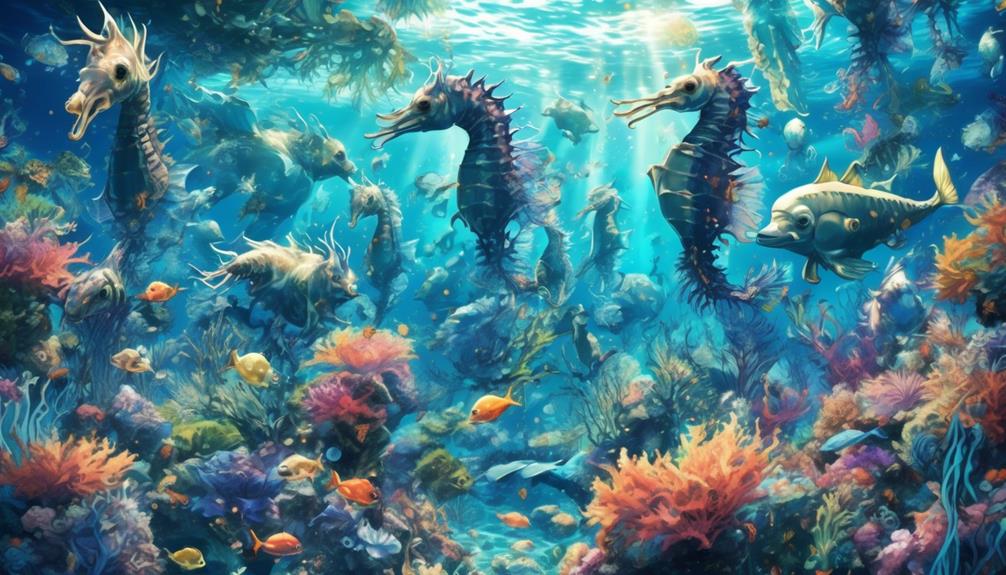
Collective Noun for Seahorses
Seahorses, those serenely swimming, spiral-tailed sea dwellers, can be a source of fascination for many. You may have seen them dancing delicately in aquariums or darting between oceanic plants in documentaries. But have you ever thought about what a group of seahorses is called?
This might not be a piece of trivia you’d expect to need, but it’s interesting, nonetheless. Just as we speak of a ‘school of fish’ or ‘pod of dolphins’, seahorses too have their unique collective noun.
Intriguing, isn’t it? Stay with us as we unravel this aquatic enigma.
Key Takeaways
- Collective nouns represent a group or collection of similar entities as a single unit.
- Collective nouns for animals often denote behavior, appearance, or characteristic traits.
- The collective noun for seahorses, ‘a herd’, reflects their equine shape.
- The choice of ‘herd’ also refers to the male seahorse carrying the eggs in a specialized pouch.
Understanding Collective Nouns
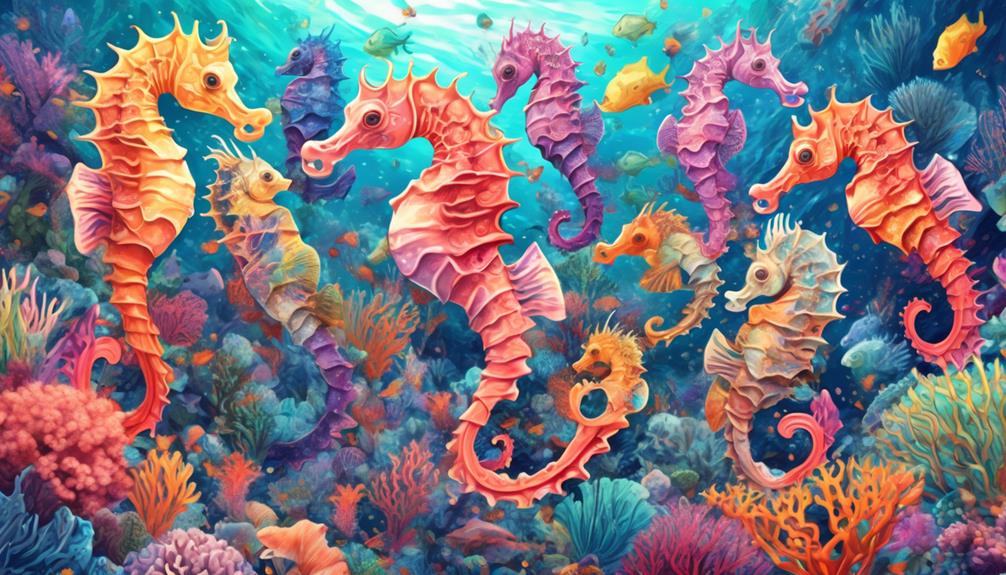
To fully appreciate the collective noun for seahorses, it’s essential to first understand what collective nouns are and how they function in our language. Collective nouns, in essence, are words that represent a group or collection of similar entities as a single unit. They’re part of language’s unique way of categorizing and simplifying the complexities of the world around you.
For instance, you don’t merely see ‘birds’; you can observe a ‘flock’ or a ‘murder’ or a ‘parliament’, depending on the species. These specific terms aren’t arbitrary; they’re steeped in cultural and historical contexts that reflect our evolving understanding of these creatures.
Furthermore, collective nouns for animals often denote behavior, appearance, or characteristic traits. They’re more than linguistic conveniences; they’re tools for communication, offering insight into how we perceive and interact with the natural world.
Applying this knowledge to seahorses, it’s not just about identifying the correct term, but also about understanding why that particular term is used. It’s a process that combines linguistics, biology, and cultural history, showcasing the intricacy and interconnectivity of knowledge.
The Mystique of Seahorses
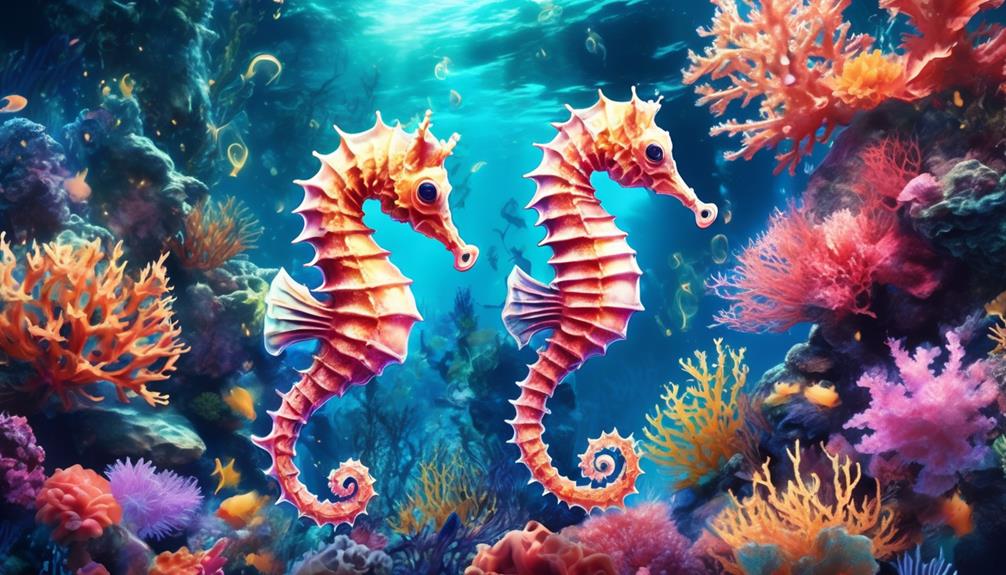
Delving into the mystique of seahorses, you’ll find these marine creatures hold a unique place not only in the underwater realm, but also in the linguistic and cultural universe we construct around them. You’ll be amazed to learn that seahorses, scientifically known as Hippocampus, are monogamous and mate for life, a rare trait in the marine world. This peculiarity has been romanticised in popular culture, adding to their mystique.
Seahorses’ distinctive morphology, with their horse-like heads and prehensile tails, make them stand out among other marine creatures. Interestingly, their peculiar body design significantly influences their swimming abilities. Unlike most fish, seahorses are poor swimmers and rely more on their ability to camouflage and anchor themselves to sea vegetation using their tails.
In the linguistic aspect, the collective noun for seahorses – ‘a herd’ – reflects their equine shape and further enhances their charm. The choice of this term, typically used for large groups of terrestrial mammals, lends a novel perspective to visualising these marine creatures.
In essence, the mystique of seahorses lies in their unique behavioural traits, distinct morphology, and the linguistic idiosyncrasies associated with them. This fusion of science, language, and culture indeed renders seahorses a fascinating subject of study.
Revealing Seahorses’ Collective Noun
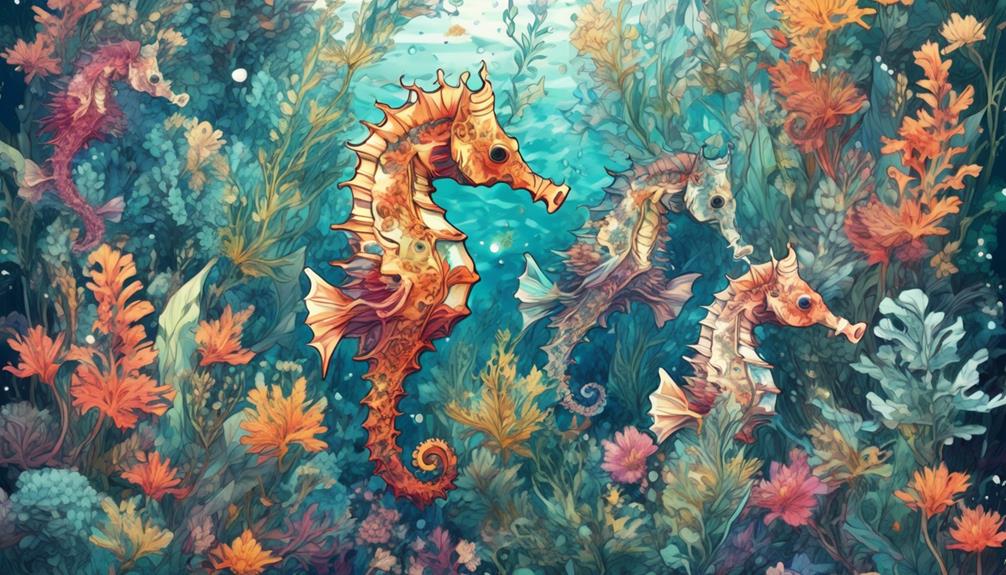
Let’s uncover the reasoning behind using ‘a herd’ as the collective noun for seahorses, a term that intriguingly juxtaposes their marine existence with terrestrial imagery.
This term, you’ll find, reflects on the unique behavior of these creatures in their natural habitat. Like a herd of terrestrial animals, seahorses move in large groups, following the ocean currents together, much like cattle or horses would roam across the plains.
However, the choice of ‘herd’ isn’t solely due to their group behavior. It also refers to the fascinating breeding habits of these creatures. Similar to a matriarchal herd, it’s the male seahorse that carries the eggs in a specialized pouch until they’re ready to hatch, a role reversal uncommon in the animal kingdom.
In essence, the term ‘herd’ encapsulates both the behavioral and reproductive traits of seahorses, providing a collective noun that’s as unique as the creatures it represents. It’s more than just a term; it’s a reflection of the intriguing complexity of marine life, reminding us that the natural world is full of surprises.
Unique Seahorse Gatherings
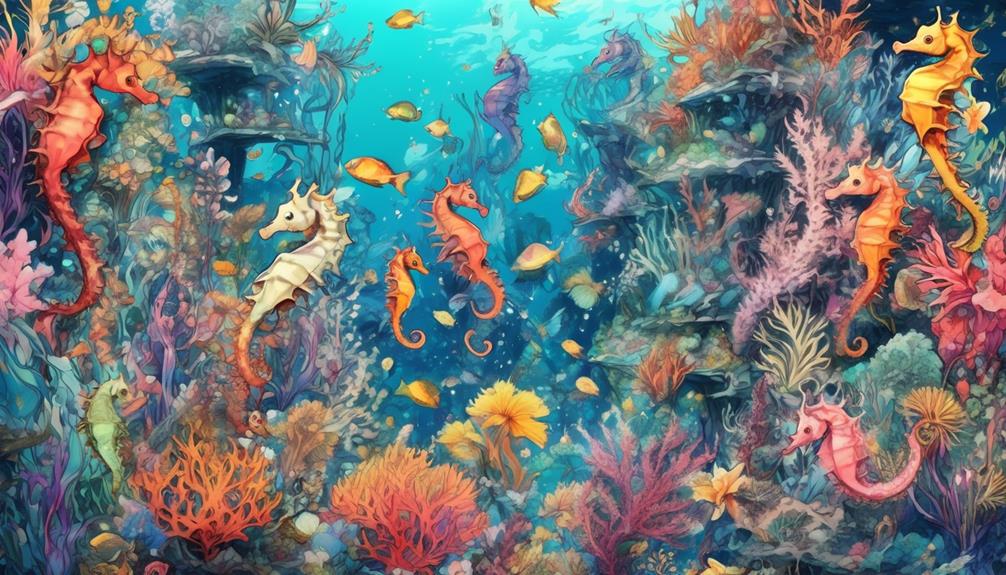
Observing the unique gatherings of seahorses, you’ll witness an enchanting spectacle of nature that encompasses peculiar mating rituals, intriguing social dynamics, and impressive survival strategies. Unlike most species, it’s the male seahorse that bears the offspring, a reproductive strategy that ensures a higher rate of survival for their young. During the courtship, females deposit eggs into the male’s brood pouch, a spectacle you’d find both fascinating and unique.
You’ll also notice an intricate ritual dance between mating partners, a behaviour that reinforces their pair bonding. Seahorses are monogamous, a rarity in the aquatic world, and these dances help strengthen their bond, ensuring they remain loyal to their chosen mate.
Moreover, seahorses often gather in seagrass beds, forming a herd, another unique behavioural trait. Here, they exhibit cryptic behaviour, blending with their environment as a survival mechanism. Their slender bodies and slow movements mimic swaying seagrass, providing an effective camouflage against predators.
Finally, you can’t miss their distinctive feeding strategy. Seahorses are ambush predators, lying in wait for unsuspecting prey. This method allows them to conserve energy, vital in their often nutrient-poor habitats.
In essence, witnessing a gathering of seahorses provides a remarkable insight into their uncommon life strategies.
Exploring Other Aquatic Collective Nouns

While the seahorse’s unique social gatherings astound, the aquatic world’s linguistic wealth in collective nouns further enhances our understanding of marine life’s complexity and diversity. Consider, for example, a ‘shoal’ of fish, used to describe a large group that moves collectively, maintaining a coordinated and polarized orientation. This term doesn’t just lump them together; it encapsulates their behavior, their interconnections, and their unity.
You might also come across a ‘pod’ of dolphins or whales, a term that highlights their social structure, the close-knit family units that make up these pods. These collective nouns aren’t random; they’re chosen with purpose, reflecting the organism’s habits, characteristics, or traits.
Another intriguing example is a ‘bloom’ of jellyfish. This term captures the spectacle of their mass gatherings, visually likened to a flower bloom in its expansiveness and beauty.
In essence, collective nouns offer more than just practical group labels. They tell a story, providing insight into the behaviors and characteristics of the species they represent. Understanding these terms can deepen your appreciation of the sea’s inhabitants and their fascinating ways of life.
Conclusion
So, you’ve journeyed through the fascinating world of seahorses and their unique collective noun – a herd.
Isn’t it interesting that these aquatic creatures gather like terrestrial animals?
You’ve also explored other aquatic collective nouns, expanding your knowledge further.
Remember, language is a fluid, evolving entity, and our understanding of it’s part of the exciting journey.
Stay curious, keep exploring, and you’ll continue to uncover the secrets held within our language’s depths.



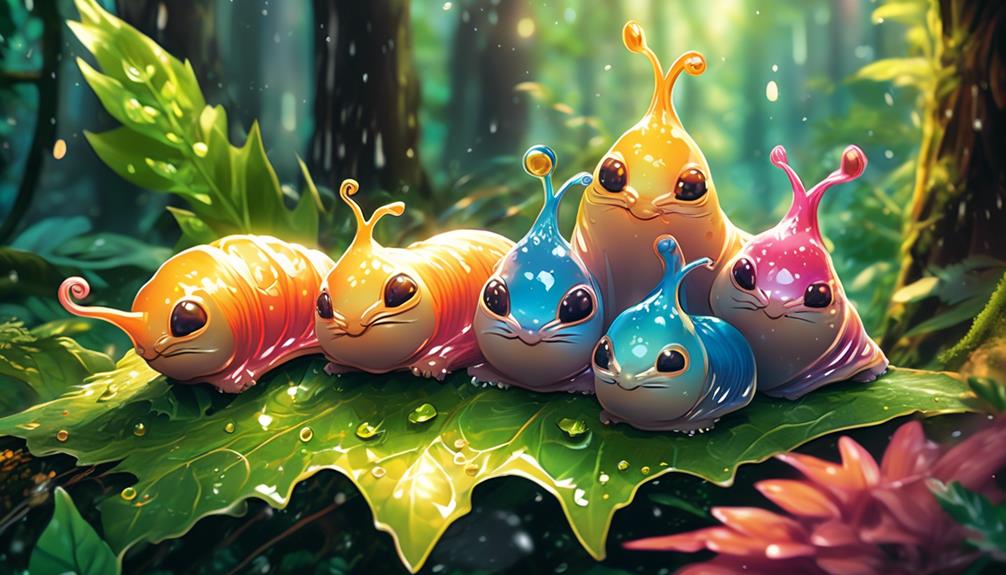

Sign up